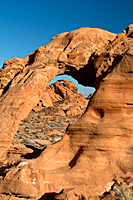This morning dawned without clouds, so we skipped sunrise and prepared to shoot Windstone Arch. This is more like a cave that David Muench made famous with one of his photographs. The trick is to shoot it after the sun rises high enough in the sky but before any direct light enters the cave. By 10:00, the good lighting was gone today.
We started by shooting a "companion arch" just off the road near Windstone Arch. The soft indirect morning light provided a soft glow of color on the sandstone. It was just the warm-up for Windstone Arch.
Windstone Arch![]() is more like a cave that is only about 3 1/2 feet tall and about 10 feet long. Just getting into Windstone Arch and getting
situated takes a major effort (and a small tripod). The space is so cramped that it's very difficult to even get your camera
in a position where you can take a portrait-format image because your camera hits the ceiling. If the difficulty
of the shot increases the appreciation of the image, we should love Windstone Arch. The shades of color, varied textures,
and the soft lighting make Windstone Arch a great subject.
is more like a cave that is only about 3 1/2 feet tall and about 10 feet long. Just getting into Windstone Arch and getting
situated takes a major effort (and a small tripod). The space is so cramped that it's very difficult to even get your camera
in a position where you can take a portrait-format image because your camera hits the ceiling. If the difficulty
of the shot increases the appreciation of the image, we should love Windstone Arch. The shades of color, varied textures,
and the soft lighting make Windstone Arch a great subject.
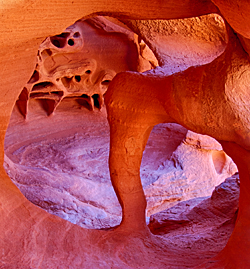
|
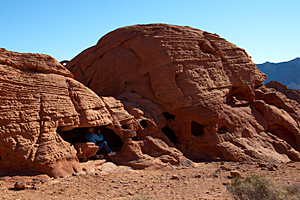
|
| Windstone Arch | Carol Photographing Windstone Arch |
After lunch, we were returning to the east end of the park to shoot Pretzel Arch, At Least 5 Hole Arch, and Little Mosquito Arch. It was going to be a very warm slog back out to the arches in the heat of the afternoon. On Tuesday, we had covered nearly 4 miles. Today would be no different...or would it?
We had to pay our campsite fees through the weekend, so we made a detour to stop by the self-pay station. As we drove around the loop to exit the campground, we noticed two groups of people pointing up at the rocks on the ridge at one end of the campground. We knew what that meant. We finished the loop and returned to the end closest to where the people were pointing. It only took a minute to find the big ram we had photographed last week along the scenic road. We parked and grabbed our long lenses. The ram was slowly making his way up a ridge so he could cross back to the side of the ridge by the scenic road. It took us about 15 minutes to work our way up the canyon ridge where we could start shooting him. As he paused to eat, we would improve our position and angle until we were just below him. We kept our distance so he could continue to feed as he climbed up through the canyon. Twice, he climbed to high points and posed for us, turning his head to ensure we each had a perfect angle for his photo shoot. He was a stud and he knew it. He couldn't have been more cooperative. Eventually, he topped the ridge and dropped down the opposite side. By that time, we each had hundreds of images of "Studlee."
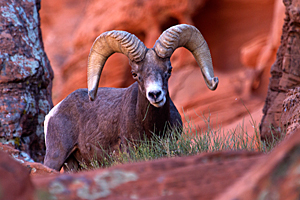
|
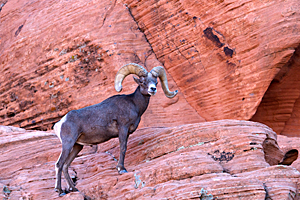
|
I tried driving the scenic road on the other side of the campground ridge, but I had no luck in finding Studlee. The effort was far from wasted. The area above Windstone Arch, which is near where he came down, provided plenty of subjects to keep me busy until the sun dropped behind the ridge in the west.
The final stop was Atlatl Rock, right outside the entrance to our campground. The Anasazi used a flat surface of a rock perched on a sandstone base for their petroglyphs. The petroglyphs are about 30 feet off the ground. The state park has built a platform and stairs so visitors can get a close look at the best rock art.
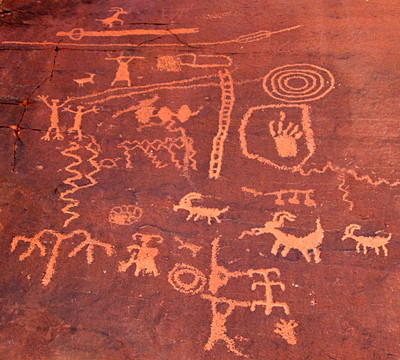
It took nearly the whole evening to download all of today's images. I think I had about 1500 images. By the time the ever-present moon rose outside our motorhome window at 11:30, "Davey" the deer mouse had made 2 or 3 appearances and I was just finishing up my backups.


